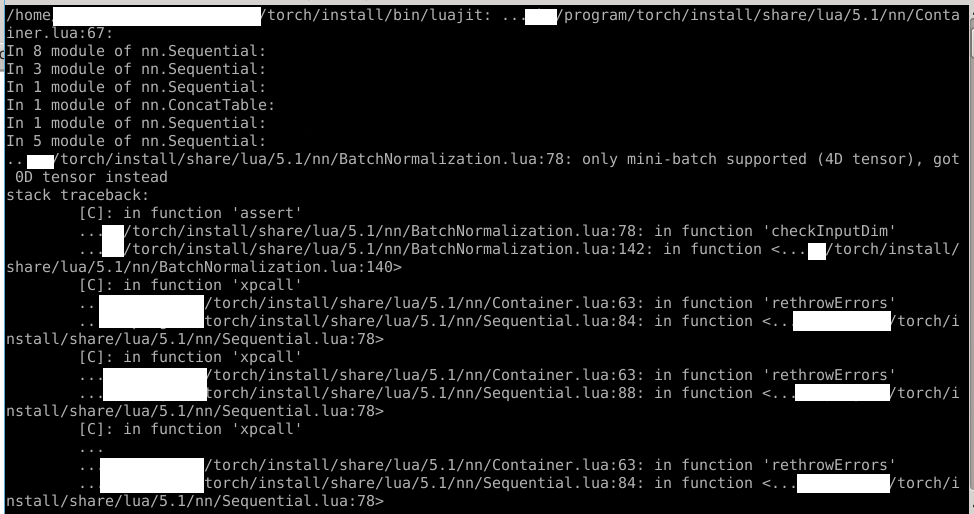转载请注明出处:
http://www.cnblogs.com/darkknightzh/p/6221664.html
参考网址:
https://github.com/torch/nn/issues/873
http://stackoverflow.com/questions/37459812/finetune-a-torch-model
https://github.com/torch/nn/blob/master/doc/module.md
https://github.com/torch/torch7/blob/master/doc/utility.md
=====================================================
170928更新(可以微调层):
参考网址:
http://www.thedataware.com/post/the-torch-adventures-setting-layer-wise-training-parameters
https://github.com/NVIDIA/DIGITS/tree/master/examples/fine-tuning
https://github.com/NVIDIA/DIGITS/blob/master/examples/fine-tuning/lenet-fine-tune.lua#L56
https://stackoverflow.com/questions/37459812/finetune-a-torch-model
https://www.zhihu.com/question/44376850
说明:目前就第一个网址的能finetune参数。
深度学习中目前有参数的为:卷积层-conv(weight+bias),batchnorm层:bn(weight+bias),全连接层-linear(weight+bias)。
因而在torch中使用local params, gradParams = model:parameters()的话,默认得到的#params为上面这三种类型的层的数量之和再乘以2。如果对应没有bias,则该层参数参数数量为1。
使用http://www.thedataware.com/post/the-torch-adventures-setting-layer-wise-training-parameters的方法,可以更新某个层。该文章是每个层设置不同的学习率,如果只某些特定的层学习率不为0,其它层学习率均为0(或者先定义fineTuneLayerIdx={10,11,12},而后for i = 1, #params改成for i = 1, #fineTuneLayerIdx来减少计算量),则会只更新这些层的参数。需要注意的是,如果fine tune最后几层还好,可以print(params),来看一下参数,然后计算一下哪些参数是需要更新的,如果更新中间的层。。。只能自己去对应了(特别是如Inception,Resnet这种网络中间层的参数,对应起来更加蛋疼了吧)。
该网址中对每层都设置学习率的代码如下:

local params, gradParams = model:parameters() -- Set the learning rate to 0.01 local learningRates = torch.Tensor(#params):fill(0.01) -- Set the learning rate of the second layer to 0.001 learningRates[2] = 0.001 optimState = {} for i = 1, #params do table.insert(optimState, { learningRate = learningRates[i], learningRateDecay = 0.0001, momentum = 0.9, dampening = 0.0, weightDecay = 5e-4 }) end for e = 1, epochs do -- Get MNIST batch X, Y = get_mnist_batch(batch_size) -- forward -> backward (outside of feval) model:zeroGradParameters() out = model:forward(X) err = criterion:forward(out, Y) gradOutputs = criterion:backward(out, Y) model:backward(X, gradOutputs) -- layer-wise optimization for i = 1, #params do local feval = function(x) return err, gradParams[i] end -- run optimizer optim.sgd(feval, params[i], optimState[i]) end end -- model trained
如果使用fineTuneLayerIdx,即只微调部分层,代码如下:

local params, gradParams = model:parameters() -- 需要finetune的参数层(不是网络层。网络层:内部可能还有更小的网络,比如densenet,resnext等; -- 参数层:正常情况下,一个conv,bn,linear等各有2个参数层,所以参数曾可能比网络成多很多) local fineTuneLayerIdx = {30,34,35} -- Set the learning rate to 0.01 local learningRates = torch.Tensor(#fineTuneLayerIdx):fill(0.01) -- Set the learning rate of the second layer to 0.001 learningRates[2] = 0.001 optimState = {} for i = 1, #fineTuneLayerIdx do table.insert(optimState, { learningRate = learningRates[i], learningRateDecay = 0.0001, momentum = 0.9, dampening = 0.0, weightDecay = 5e-4 }) end for e = 1, epochs do -- Get MNIST batch X, Y = get_mnist_batch(batch_size) -- forward -> backward (outside of feval) model:zeroGradParameters() out = model:forward(X) err = criterion:forward(out, Y) gradOutputs = criterion:backward(out, Y) model:backward(X, gradOutputs) -- layer-wise optimization for i = 1, #fineTuneLayerIdx do local feval = function(x) return err, gradParams[fineTuneLayerIdx[i]] end -- run optimizer optim.sgd(feval, params[fineTuneLayerIdx[i]], optimState[i]) end end -- model trained
需要注意的是,如果使用model:parameters(),需要optimState为多个table,不能为下面这样简单的一个table:
optimState = { -- 使用model:parameters()时,使用这种optimState有问题
learningRate = learningRates,
learningRateDecay = 0.0001,
momentum = 0.9,
dampening = 0.0,
weightDecay = 5e-4
}
否则在第二次运行到optim.sgd(feval, params[fineTuneLayerIdx[i]], optimState[i])时,可能会提示维度不一样。
另外,https://www.zhihu.com/question/44376850中“知乎用户”的回答也和这个类似,只不过不知道那个网址中的和这个网址中的谁先谁后吧。
如果使用https://stackoverflow.com/questions/37459812/finetune-a-torch-model中的方法,即:
for i=1, x do c = model:get(i) c.updateGradInput = function(self, inp, out) end c.accGradParameters = function(self,inp, out) end end
我这边有conv、bn,linear这三种层,会提示下面bn层的错误,不清楚是我这边程序的问题,还是怎么回事。

如果使用https://github.com/NVIDIA/DIGITS/blob/master/examples/fine-tuning/lenet-fine-tune.lua#L56这种方法,其实和上面的类似,只不过没有设置每层的updateGradInput这个。只设置一个的话,同样的输入,每次输出不一样(我把所有的conv,bn,linear都设置了= function(self, inp, out) end,为了看一下输出是否一致。理论上如果这些层参数都不更新,同样的输入,最终的输出应该相同),即感觉没能fine tune特定的层。
170928更新结束
=====================================================
161229更新:
感谢@linzhineng 。
即便按照本文这样设置,实际上在微调时,其它层的参数还是会变化。现在凌乱了,不清楚如何微调了/(ㄒoㄒ)/~~
难道只能手动修改更新过程吗?
161229更新结束:
=====================================================
由于torch每个模块均有train参数,当其为true时进行训练,当期为false时进行测试。因而,如果要对训练好的模型进行微调,如只对某模块调整参数,其他模块参数固定,则可以使用第一个参考网址中soumith的方法(该方法固定某模块,和本文目的是反的):
model:training() model:apply(function(m) if torch.type(m):find("BatchNormalization") then m:evaluate() end end)
说明:一般来说,在训练时,需要设置model:training(),在测试时,需要设置model:evaluate()。因而微调参数时,上面代码加在训练代码中model:training()后面就可以了(需要适当的修改)。
第四个网址给出了[string] torch.type(object)。因而,对上面的代码修改如下:如果要达到微调某一模块参数(如全连接层Linear),只需要使用:
model:evaluate() model:apply(function(m) if torch.type(m):find('Linear') then m:training() end end)
说明:上面代码测试后成功。但是遇到了一个很诡异的问题。如果第一行改为model:training(),在找到对应的层后,改为m: evaluate (),没有成功(对应的torch.type(m):find('Linear')==nil),所以才使用了上面的代码。还有一点,如果判断torch.type(m):find('Linear')==nil,最后没有成功改了m的train变量的值,具体不太清楚,最终使用了上面给出的代码。
上面torch.type(m)会返回模块的名字,如:
nn.Sequential
nn.SpatialConvolution
nn.SpatialBatchNormalization
nn.ReLU
nn.SpatialMaxPooling
nn.SpatialConvolution
nn.SpatialBatchNormalization
nn.ReLU
上面torch.type(m):find("BatchNormalization"),如果在某层找到了BatchNormalization,则返回找到的起始和结束位置,否则返回nil。
还有,微调时,一般都只微调某一层,但是torch中很多层名字相同,如果要改特定的一层,如conv层,还要继续修改代码,判断是否是需要的那个conv层,否则会将所有的conv层参数都修改。
注意:如果网络定义使用了Inception层,此处不光返回Inception,还会返回Inception里面各个层(如nn.Sequential,nn.InceptionHisign,nn.DepthConcat等)。
在torch/install/share/lua/5.1/nn/Module.lua中,有如下代码:
function Module:training() self.train = true end function Module:evaluate() self.train = false end
直觉上,torch中这种方式不如caffe的fine tuning时,设置对应层lr_mult=0容易。
第三个网址有对apply,training,evaluate的较详细的说明。
此外,第二个网址通过updateGradInput和accGradParameters来达到固定某层参数的效果,不过没有试过。
